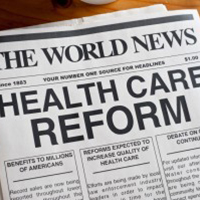Happy 12th Birthday, Affordable Care Act—You’ve Grown So Much!

By Karen Davenport
So much has changed since 2010—politically, culturally, economically, and more. We are two years into a global pandemic, the guy from Twilight is the new Batman, general inflation is outpacing health care inflation, and more than 91 percent of people in the U.S. have health insurance.
The Affordable Care Act Resulted in Historic Coverage Gains
When President Obama signed the Affordable Care Act (ACA) on March 23, 2010, more than half of the people in the United States received health coverage through their employer or a family member’s employer, while millions more held coverage through Medicare or Medicaid for all or part of the year. And that’s still true; the ACA didn’t reorganize the entire health insurance system; instead, it built on that foundation to expand the financial protection and greater access to health services that are a hallmark of health coverage to many who had previously been excluded from insurance by corporate rules, legal restrictions, and cost.
The ACA took on those barriers to health coverage by 1) creating new rules for health insurance companies (for example, prohibiting them from denying coverage to people with pre-existing conditions or charging people higher premiums just because they are sick); 2) expanding eligibility for Medicaid (ultimately a state decision, following the ACA’s first trip to the Supreme Court); 3) providing financial help to reduce the cost of private coverage and associated cost-sharing expenses, and 4) creating a new venue for comparing and purchasing comprehensive health insurance. All of these elements combined resulted in the largest single year-to-year drop in the uninsurance rate on record in the first year of the law’s full implementation. Over time, the nation’s uninsurance rate has fallen from 16.3 percent in 2010, the year the ACA passed, to 8.6 percent in 2020.
Not surprisingly, some of the groups notably benefitting from these coverage expansions are the people who were systematically excluded from coverage in the past. Uninsurance rates for Black and Hispanic adults, for example, fell as or more dramatically than uninsurance rates among the general population from 2013 to 2017. Uninsurance among adults ages 50 to 65, who are more likely to have a health history that would have previously caused insurers in the individual market to exclude them from coverage, fell from 15 percent in 2010 to 6 percent in 2015.
Millions Lacking Comprehensive Health Insurance Underscore the Need for Further Action
Despite this progress, 28 million people in the U.S. were uninsured in 2020. Even upon the ACA’s passage, experts knew that gaps would remain after the new law’s insurance reforms and new coverage opportunities went into effect. Non-citizens, for example, have fewer pathways to health insurance coverage; federal law bars lawfully present immigrants from enrolling in Medicaid for their first five years of residence, while the ACA itself prohibits undocumented immigrants from purchasing either subsidized or unsubsidized marketplace coverage. The infamous “family glitch,” which links eligibility for premium subsidies to the cost of worker-only coverage, rather than more-expensive and often less-affordable family coverage, has left marketplace coverage out of reach for up to 6.1 million people. In addition, increases in marketplace premiums over time made coverage far less affordable for individuals and families with incomes just above the eligibility threshold for premium tax credits. Further, the Supreme Court’s decision to leave the ACA’s Medicaid eligibility expansion up to the states left more than 2 million adults—60 percent of whom are people of color—without affordable coverage opportunities in the 12 states that have yet to embrace this key component of the law.
One silver lining of the COVID-19 pandemic has been that Congress recognized the need to fill some of these gaps as the nation stared down the combination of a novel virus and the economic upheaval that followed in its wake. In early 2021, Congress passed legislation significantly—albeit temporarily—expanding premium tax credits. Through the end of the 2022 plan year, tax credits are more generous and, for the first time, are available to individuals and families with incomes over 400 percent of the federal poverty level. These time-limited changes were expected to expand coverage to nearly 2 million people and enabled others to maintain their marketplace coverage throughout the pandemic. The marketplaces saw record signups during the most recent open enrollment period. Congress also created financial incentives for states to keep Medicaid enrollees continuously covered until the COVID-19 Public Health Emergency (PHE) ends, regardless of income or other eligibility changes. Thanks to this policy, approximately 14 million people have held stable Medicaid coverage throughout the pandemic who might otherwise have scrambled for health insurance or become uninsured. And now the Biden Administration appears poised to fix the family glitch, thus expanding tax credit eligibility to millions more.
Still, the ACA has not fully realized its promise. The expanded scope of marketplace premium tax credits will expire at the end of this year unless Congress takes action, and millions still lack an affordable source of coverage, such as those the Medicaid coverage gap. But just as my daughter, two years old when the ACA was enacted, has entered high school and moved from occasional tantrums to strong rhetorical skills and deeply-held beliefs, the ACA has grown and matured over the last 12 years. In the process, it has become the bedrock of our health insurance system, providing millions of Americans with financial protection and the ability to access critical health care services in both the extraordinary circumstances of a pandemic and much-more-ordinary times.








